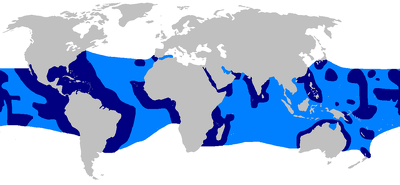Home | Category: Shark Species
SILKY SHARKS
Silky sharks (Scientific name: Carcharhinus falciformis) also are known by a variety of names including sickle shark, silk shark, reef shark;, blackspot shark, gray whaler, olive shark, ridgeback shark, sickle-shaped shark and sickle silk shark. They are a species of requiem shark, named for the smooth texture of their skin. [Source: Wikipedia]
Silky sharks are among the most numerous pelagic shark. Highly mobile and migratory, they can be found around the world in tropical waters and are most commonly found over the edge of the continental shelf down to 50 meters (164 ft). The silky shark has a slender, streamlined body and typically reaches lengths of aound 2.5 meters (8 feet 2 inches). It can be distinguished from other large requiem sharks by its relatively small first dorsal fin with a curving rear margin, its tiny second dorsal fin with a long free rear tip, and its long, sickle-shaped pectoral fins. It is a deep, metallic bronze-gray above and white below.
The average lifespan of silky sharks in the wild is 23 years. The age of silky sharks can be determined by counting the number of growth rings that develop on their vertebrae, with each band representing approximately one year of life. Adult silky sharks have very few predators ofther than humans. They may occasionally hunted by orcas or larger sharks. Juveniles and smaller adults sometimes are taken by larger, more mature sharks. Juveniles and small individuals often form schools to avoid predation. [Source: Jessica Frazelle, Animal Diversity Web (ADW) /=]
Silky sharks are one of the three most coveted species in the shark fin trade. Their numbers declined 63 percent between 1995 and 2020. Silky sharks have accounted for three non-fatal unprovoked attacks and zero fatal attacks according to the International Shark Attack Files of the Florida Museum of Natural History, 2023; [Source: Mónica Serrano and Sean McNaughton, National Geographic, July 15, 2021]]
Related Articles: COASTAL SHARKS: BLACKTIP, SAND TIGER, AND DUSKY SHARKS ioa.factsanddetails.com; OPEN OCEAN SHARKS: BLUE SHARKS AND OCEANIC WHITETIP SHARKS ioa.factsanddetails.com; SHARKS AND RAYS ioa.factsanddetails.com; HUMANS, SHARKS AND SHARK ATTACKS ioa.factsanddetails.com; SHARKS: CHARACTERISTICS, SENSES AND MOVEMENT ioa.factsanddetails.com ; SHARK BEHAVIOR: INTELLIGENCE, SLEEP AND WHERE THEY HANG OUT ioa.factsanddetails.com ; SHARK SEX: REPRODUCTION, DOUBLE PENISES, HYBRIDS AND VIRGIN BIRTH ioa.factsanddetails.com ; SHARK FEEDING: PREY, HUNTING TECHNIQUES AND FRENZIES ioa.factsanddetails.com
Websites and Resources: Shark Foundation shark.swiss ; International Shark Attack Files, Florida Museum of Natural History, University of Florida floridamuseum.ufl.edu/shark-attacks ; Animal Diversity Web (ADW) animaldiversity.org; National Oceanic and Atmospheric Administration (NOAA) noaa.gov; Fishbase fishbase.se ; Encyclopedia of Life eol.org ; Smithsonian Oceans Portal ocean.si.edu/ocean-life-ecosystems
Silky Shark Habitat and Where They Are Found
Silky sharks live in temperate, tropical, saltwater and marine environments are found throughout the Pacific, Atlantic, and Indian Oceans between 40°N latitude and 40°S latitude. Among the world’s most abundant shark species, you can find them in reefs, other coastal areas and the open sea. They are typically found at depths of 18 to 500 meters (59 to 1640 feet), with an average of around 200 meters (656 feet). [Source: Jessica Frazelle, Animal Diversity Web (ADW) /=]
Silky sharks are highly migratory. Those in both the Pacific and Indian Oceans move to slightly higher latitudes during the summer months. Those residing in the Atlantic Ocean tend to follow the Gulf Stream and the migrations of tuna, their primary prey. Silky sharks have been observed gathering in large numbers in the Gulf of Aden, the Gulf of Mexico, and along the coast of southern Baja California.
Silky sharks primarily inhabit tropical oceans with temperatures above 23°C (73̊F) . They are mostly found continental and insular shelves, but have also been observed in shallow, coastal areas, over deep water reefs, on continental slopes and in the open ocean. Silkies have a wider latitudinal distribution along continental shelves compared to the open ocean or along insular shelves.
Silky sharks live and transition between different habitats during different stages of their life cycle,. In the early years of life, juveniles live in nursery grounds close to the floor with forays into the open ocean. When they become young adults — with a length of about 1.3 meters (4.3 feet) — they migrate offshore to deeper waters. At this stage, they often follow large schools of pelagic fish such as tuna, providing them with a steady supply of food. Adult silky sharks spend most of their time in deeper waters but return seasonally to continental and insular shelf areas to feed and reproduce.
Silky Shark Physical Characteristics
Silk sharks are endothermic (use their metabolism to generate heat and regulate body temperature independent of the temperatures around them) and heterothermic (have a body temperature that fluctuates with the surrounding environment). They range in length from 1.8 to 3.5 meters (5.9 to 11.5 feet), with their average length being 2.5 meters (8.2 feet). They range in weight from 178 to 346 kilograms (392 to 762. pounds). Females are larger than males Female silky sharks range from 2.1 to 2.3 meters (7 to 7.5 feet) in length when they reach maturity whereas male silky sharks range from 1.8 to 2.1 meters (6 to 7 feet). .
According to Animal Diversity Web: Silky sharks get their name from the silky feel of their hide. Their skin, as in other shark species, is covered with dermal denticles. However, the unusually dense packing of these structures in this species makes their skin feel much softer to the touch than the rougher skin that is commonly associated with sharks. Another distinctive feature of silky sharks is the shape of their teeth. They have between 14 to 17 teeth on each side their upper jaws, and these teeth are notched or serrated rather than concave, which is the condition in most other species of sharks.The dorsal coloration of this species can vary greatly, from a dark brown to a blue-grey color. The ventral surface is generally white, but in some individuals the ventral surface of the pelvic and pectoral fins can have darkly colored tips. [Source: Jessica Frazelle, Animal Diversity Web (ADW) /=]
Silky sharks are the largest members of their genus, Carcharhinus. Unlike most members of the genus the pectoral fins of this species are sickle-shaped. The first dorsal fin is relatively small, with a rounded apex, which originates behind the pectoral fins. The second dorsal fin is also very small, with a long trailing tip that almost reaches the precaudal pit, which is a notch on the dorsal side of the shark that is located where the caudal fin, or tail fin, begins. Silky sharks have paired nostrils beneath their snouts, which function as tunnels with two openings separated by a fleshy flap. As the shark swims forward, water flows over the olfactory glands, allowing the shark to “smell” the water.
Silky Shark Behavior
Silky sharks are diurnal (active during the daytime), nocturnal (active at night), crepuscular (active at dawn and dusk), motile (move around as opposed to being stationary), and migratory (make seasonal movements between regions, such as between breeding and wintering grounds) and solitary. Their home range appears to be poorly defined. They do seem to favor, however, certain migratory routes and core areas over others. Studies have shown that silky shark individuals have unique movement patterns based on prey preference and migration. [Source: Jessica Frazelle, Animal Diversity Web (ADW) /=]
Silky sharks are generally solitary, but they do travel in groups. According to Animal Diversity Web: Juveniles in particular primarily travel in groups until they reach maturity, a strategy that is thought to protect them from larger predators. Even at adult stages, silky sharks can be quite social with conspecifics and often intermix with schooling scalloped hammerheads. Studies have shown that silky sharks may segregate according to size, as travelling groups tend to be composed of individuals of similar size classes. These sharks have been recorded to be active during both the day and at night but they usually reach a peak in daily activity around dawn and around dusk. /=\
When migrating, silky sharks often follow the movements of schooling fish such as tuna. They travel alone and in groups depending on the individual shark. Silky sharks are known for their quick and aggressive behavior, and have been seen performing threat displays in which they raise their head, arch their back, and lower their tail. Several shark species display this behavior in situations dealing with territory, mates, and predators. They are very inquisitive and will often make close non-aggressive passes to divers.
Silky sharks communicate with vision and chemicals usually detected by smelling. They also employ pheromones (chemicals released into air or water that are detected by and responded to by other animals of the same species) and sense using vision, touch, sound, vibrations, electric signals and chemicals that can be detected by smelling. Silky sharks have been observed communicating using aggression displays, involving a raised head, arched back, and lowered tail. Males can also communicate by releasing pheromones into the water to attract females and ward off challenging males. /=\
Silky Shark Food and Eating Behavior
Silky sharks are generalist carnivores (animals that mainly eat meat or animal parts) and typically feed on various species of fish, squid, and pelagic crabs, including red crab, jumbo squid , and chub mackerel. Young silky sharks primarily feed upon jumbo squid, while adult silky sharks consume more red crabs and chub mackerel. Yellowfin tuna, albacore, mullet , and porcupine have been found in the stomachs of silky sharks. [Source: Jessica Frazelle, Animal Diversity Web (ADW) /=]
According to Animal Diversity Web: Variation in diet of silky sharks depends on the availability and abundance of prey. Other factors that affect their diet include the size and energy content of prey items, and seasonal changes in their availability. They primarily feed on schooling fish, most likely because of an increased likelihood of catching more prey, which reduces the amount of energy used in foraging. When food is limited, silky sharks act as opportunistic feeders, consuming a wide variety of prey from different habitats and depths in the open ocean. When food is abundant, they may be more selective in what they eat.
There has been very little research conducted specifically on how silky sharks communicate and locate prey but, as with other shark species, they have several highly-developed senses. They have a superior sense of smell and can detect a single drop of blood in 100 L of water. Silky sharks are also very sensitive to electrical frequencies and can accurately hear sounds 80 Hz and below, as well as sounds up to 800 or 1000 Hz. They can hear sounds that are imperceptible to the human ear such as the sounds of struggling prey, or the drumming of bony fish. It is thought that sharks have the ability to determine the direction a sound is coming from using their lateral line, or acousticolateralis system. This system is composed of small bundles of sensory cells called neuromasts which are located in pores along the head and body. [Source: Jessica Frazelle, Animal Diversity Web (ADW) /=]
Silky Shark Mating and Reproduction
Silky sharks are ovoviviparous (eggs are hatched within the body of the parent) and iteroparous (offspring are produced in groups such as litters multiple times in successive annual or seasonal cycles). They engage in internal reproduction in which sperm from the male fertilizes the egg within the female. [Source: Jessica Frazelle, Animal Diversity Web (ADW) /=]
Silky sharks engage in seasonal breeding and year-round breeding. They breed every two years. In tropical waters, silky sharks breed year-round. In the warm-temperate waters of the Gulf of Mexico, silky sharks breed during the summer months (June, July, and August). The average gestation period is 12 months. The number of offspring ranges from two to 14. Females reach sexual or reproductive maturity at seven to 12 years, on average at age eight years. Males reach sexual or reproductive maturity at six to 10 years, on average around 6.5 years.
Silky sharks are polygynous (males having more than one female as a mate at one time). Mating rituals for the species are unknown. During the mating process, the male inserts his claspers into the female's cloaca, releasing sperm. Males mate with multiple females during a breeding season. According to Animal Diversity Web: Males release pheromones (chemicals released into air or water that are detected by and responded to by other animals of the same species); however, it is uncertain as to whether or not the pheromones are used to attract mates, ward off competition, mark territory, or some combination of the three. Additionally, studies have shown that no sexual segregation exists within silky shark populations. Pheromones do not play a role in determining social structure, meaning that silky sharks do not travel together solely for mating purposes. Rather, size appears to be the determing factor in social structure, with co-travelling generally being of the same size class.
Silky Shark Offspring and Development
Silky sharks give birth to live young. Parental care, provisioning and protecting is provided by females during the pre-birth stage but not after birth. The gestation period for silky sharks averages 12 months. Females provide continual nutrition to their developing young throughout the developmental process through the placenta. In females, the oviducts are modified to form uteri, with only the right ovary being functional. The embryos develop in longitudinally-oriented individual chambers, with their heads pointing towards the tail in the uterus of the mother.
Silky sharks range in length from 70 to 75 centimeters (2.3 to 2.5 feet) when they are born. They are considered capable predators at birth. Juveniles rapidly grow an additional 25 to 35 centimeters (10 to 13 inches) by their first winter, which is thought to enhance their survival.
Reproductive maturity is reached at and 2.1 to 2.3 meters (7-7.5 feet) in length in females and 1.8 to 2.1 meters (607 feet) in males. According to Animal Diversity Web: Silky sharks in the Indian Ocean and in the Pacific Ocean achieve maturity at younger ages and at smaller sizes than silky sharks in other areas (approximately two years younger and 0.3 to 0.6 meters shorter). It is thought that the variation in size at maturity might be related to latitude, with sharks in tropical waters (areas of low latitude) tending to grow faster and mature at earlier stages of life. This may be due to warmer waters causing an increase in metabolism, thus speeding up growth rates, but the mechanism responsible is in need of additional research and confirmation. (Joung, et al., 2008; Knickle, 2012; MarineBio. org, 2012; Martin, 2007; Michael, 2005) /=\
Humans, Silky Sharks and Conservation
Humans utilize silk sharks for research, education and food. Their body parts are sources of valuable materials. Silky sharks have been the subject of many scientific studies surrounding the sensory biology of sharks. Silky sharks are also one of the most common sources of dried shark jaws sold to tourists in tropical countries. [Source: Jessica Frazelle, Animal Diversity Web (ADW) /=]
The International Union for Conservation of Nature (IUCN) Red List lists silk sharks are “Near Threatened”. They have no special status according to the Convention on the International Trade in Endangered Species (CITES). Silky sharks are known to follow schools of tuna and are often caught as a by-catch in tuna fisheries. They are also harvested by directed pelagic shark fisheries, and taken by recreational fisherman.
Silky sharks are also among the most common bycatch species in the tuna fishing process, making up 70 to 80 percent of the pelagic longline catch off the coast of the Maldives and Sri Lanka. Many fishermen cut off their fins for shark fin soup trade and sometimes sell the meat and oils. They are vulnerable to overfishing because of their long gestation period, low number of offspring, and slow growth rate. However, the sampling of silky shark populations in tropical waters has been minimal. It is estimated that their population decreased by 85 percent over the course between 1984-2005 and is continuing to decrease. These numbers are not regarded as reliable due to the under-reporting of catch rates and lack of population monitoring. States and areas that allow fishing of silk sharks have been encouraged to cooperate with international efforts to reign in the practice but thus far plan to regulate it have not come to druition.
Image Source: Wikimedia Commons, NOAA
Text Sources: Animal Diversity Web (ADW) animaldiversity.org; National Oceanic and Atmospheric Administration (NOAA) noaa.gov; Wikipedia, National Geographic, Live Science, BBC, Smithsonian, New York Times, Washington Post, Los Angeles Times, The New Yorker, Reuters, Associated Press, Lonely Planet Guides and various books and other publications.
Last Updated March 2023





